Gennaro Cuofano's Blog, page 131
December 30, 2021
What Are ESG Criteria? ESG Criteria In A Nutshell
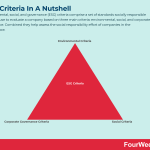

Environmental, social, and governance (ESG) criteria comprise a set of standards socially responsible investors use to evaluate a company based on three main criteria: environmental, social, and corporate governance. Combined they help assess the social responsibility effort of companies in the marketplace.
Understanding ESG criteriaPlatforms such as Robinhood and Wealthfront have made investing more accessible to a new generation of investors who prefer to invest in companies whose values align with their own. Climate change, social unrest, and the coronavirus pandemic have also increased awareness about the interconnectedness of sustainability and the financial system.
In response to these trends, brokerage firms and mutual fund companies now offer exchange-traded funds (ETFs) and other financial products that respect various environmental, social, and governance criteria.
Data released by The Forum for Sustainable and Responsible Investment shows the total US-domiciled assets under management using sustainable investment strategies reached $17.1 trillion in 2020. This figure constituted around 33% of the total assets under professional management in the United States.
While rarely mentioned in mandatory financial reporting, many investors evaluate ESG criteria to better understand the various companies in their investment portfolio. Indeed, investors consider companies that share their values and concerns about the world, with the profitability and risk of the company a secondary concern at best.
In the following sections, we will discuss some specific criteria for each category. Before we proceed, however, it should be noted that there is no exhaustive or definitive list of ESG criteria. Furthermore, some criteria are interrelated and it can be difficult to assign one to a single category.
Environmental criteriaEnvironmental criteria deal with the conservation of the natural world and external factors not affected by market mechanisms that can impact company revenue.
Examples include:
Air and water pollution.Waste management.Climate change and greenhouse gas emissions.Biodiversity, andDeforestation.Microsoft recently became the first company among its peers to target a “carbon negative” status by the year 2030. To that end, the company created a $1 billion fund to reduce emissions and remove all the carbon it has emitted since it was founded in 1975.
Social criteriaSocial criteria encompass the various relationships a company has with people, institutions, and communities. Since every company operates within a broader society, the way in which it carries itself is critical to attracting socially responsible investors.
Examples of social criteria include:
Customer satisfaction.Community relations and involvement. Human rights.Employee engagement, andData protection and privacy.Graphics card manufacturer NVIDIA has a strict policy to never use conflict minerals in its products. The company’s Conflict Minerals Policy ensures that gold, tantalum, tungsten, and tin purchased from the Democratic Republic of Congo do not directly or indirectly finance armed militia groups.
Corporate governance criteriaCorporate governance criteria are assessed by investors to ensure the company uses accurate and transparent accounting methods, avoids potential conflicts of interest, and allows shareholders to vote on important issues.
Governance criteria include:
Bribery and corruption.Executive compensation.Shareholder rights.Political contributions and lobbying.Audit committee structure, andHiring and onboarding best practices.Pharmaceutical giant GlaxoSmithKline (GSK) is working toward at least 45% female representation in senior roles before the end of 2025. Construction and infrastructure company Emcor Group is also known for giving employees unprecedented encouragement to raise potential ethics breaches.
Key takeaways:Environmental, social, and governance (ESG) criteria comprise a set of standards socially responsible investors use to evaluate a company. Younger investors are considering ESG criteria as the basis for investment decisions, with less credence given to profitability or risk.Environmental criteria encompass the natural world and external market mechanisms, including water pollution, air pollution, climate change, waste management, and deforestation.Social criteria describe the relationships a company has with wider society and the reputation it earns as a consequence. Governance criteria, on the other hand, may include executive compensation, shareholder rights, and recruitment best practices.Main Free Guides:
Business ModelsBusiness StrategyBusiness DevelopmentDigital Business ModelsDistribution ChannelsMarketing StrategyPlatform Business ModelsRevenue ModelsTech Business ModelsBlockchain Business Models FrameworkConnected Business Frameworks To The ESG Criteria Change is an important and necessary fact of life for all organizations. But change is often unsuccessful because the people within organizations are resistant to change. Change management is a systematic approach to managing the transformation of organizational goals, values, technologies, or processes.
Change is an important and necessary fact of life for all organizations. But change is often unsuccessful because the people within organizations are resistant to change. Change management is a systematic approach to managing the transformation of organizational goals, values, technologies, or processes. An effective risk management framework is crucial for any organization. The framework endeavors to protect the organization’s capital base and revenue generation capability without hindering growth. A risk management framework (RMF) allows businesses to strike a balance between taking risks and reducing them.
An effective risk management framework is crucial for any organization. The framework endeavors to protect the organization’s capital base and revenue generation capability without hindering growth. A risk management framework (RMF) allows businesses to strike a balance between taking risks and reducing them. Timeboxing is a simple yet powerful time-management technique for improving productivity. Timeboxing describes the process of proactively scheduling a block of time to spend on a task in the future. It was first described by author James Martin in a book about agile software development.
Timeboxing is a simple yet powerful time-management technique for improving productivity. Timeboxing describes the process of proactively scheduling a block of time to spend on a task in the future. It was first described by author James Martin in a book about agile software development. Herzberg’s two-factor theory argues that certain workplace factors cause job satisfaction while others cause job dissatisfaction. The theory was developed by American psychologist and business management analyst Frederick Herzberg. Until his death in 2000, Herzberg was widely regarded as a pioneering thinker in motivational theory.
Herzberg’s two-factor theory argues that certain workplace factors cause job satisfaction while others cause job dissatisfaction. The theory was developed by American psychologist and business management analyst Frederick Herzberg. Until his death in 2000, Herzberg was widely regarded as a pioneering thinker in motivational theory. The Kepner-Tregoe matrix was created by management consultants Charles H. Kepner and Benjamin B. Tregoe in the 1960s, developed to help businesses navigate the decisions they make daily, the Kepner-Tregoe matrix is a root cause analysis used in organizational decision making.
The Kepner-Tregoe matrix was created by management consultants Charles H. Kepner and Benjamin B. Tregoe in the 1960s, developed to help businesses navigate the decisions they make daily, the Kepner-Tregoe matrix is a root cause analysis used in organizational decision making. The ADKAR model is a management tool designed to assist employees and businesses in transitioning through organizational change. To maximize the chances of employees embracing change, the ADKAR model was developed by author and engineer Jeff Hiatt in 2003. The model seeks to guide people through the change process and importantly, ensure that people do not revert to habitual ways of operating after some time has passed.
The ADKAR model is a management tool designed to assist employees and businesses in transitioning through organizational change. To maximize the chances of employees embracing change, the ADKAR model was developed by author and engineer Jeff Hiatt in 2003. The model seeks to guide people through the change process and importantly, ensure that people do not revert to habitual ways of operating after some time has passed. The CATWOE analysis is a problem-solving strategy that asks businesses to look at an issue from six different perspectives. The CATWOE analysis is an in-depth and holistic approach to problem-solving because it enables businesses to consider all perspectives. This often forces management out of habitual ways of thinking that would otherwise hinder growth and profitability. Most importantly, the CATWOE analysis allows businesses to combine multiple perspectives into a single, unifying solution.
The CATWOE analysis is a problem-solving strategy that asks businesses to look at an issue from six different perspectives. The CATWOE analysis is an in-depth and holistic approach to problem-solving because it enables businesses to consider all perspectives. This often forces management out of habitual ways of thinking that would otherwise hinder growth and profitability. Most importantly, the CATWOE analysis allows businesses to combine multiple perspectives into a single, unifying solution. Agile project management (APM) is a strategy that breaks large projects into smaller, more manageable tasks. In the APM methodology, each project is completed in small sections – often referred to as iterations. Each iteration is completed according to its project life cycle, beginning with the initial design and progressing to testing and then quality assurance.
Agile project management (APM) is a strategy that breaks large projects into smaller, more manageable tasks. In the APM methodology, each project is completed in small sections – often referred to as iterations. Each iteration is completed according to its project life cycle, beginning with the initial design and progressing to testing and then quality assurance. A holacracy is a management strategy and an organizational structure where the power to make important decisions is distributed throughout an organization. It differs from conventional management hierarchies where power is in the hands of a select few. The core principle of a holacracy is self-organization where employees organize into several teams and then work in a self-directed fashion toward a common goal.
A holacracy is a management strategy and an organizational structure where the power to make important decisions is distributed throughout an organization. It differs from conventional management hierarchies where power is in the hands of a select few. The core principle of a holacracy is self-organization where employees organize into several teams and then work in a self-directed fashion toward a common goal. The CAGE Distance Framework was developed by management strategist Pankaj Ghemawat as a way for businesses to evaluate the differences between countries when developing international strategies. Therefore, be able to better execute a business strategy at the international level.
The CAGE Distance Framework was developed by management strategist Pankaj Ghemawat as a way for businesses to evaluate the differences between countries when developing international strategies. Therefore, be able to better execute a business strategy at the international level. First proposed by accounting academic Robert Kaplan, the balanced scorecard is a management system that allows an organization to focus on big-picture strategic goals. The four perspectives of the balanced scorecard include financial, customer, business process, and organizational capacity. From there, according to the balanced scorecard, it’s possible to have a holistic view of the business.
First proposed by accounting academic Robert Kaplan, the balanced scorecard is a management system that allows an organization to focus on big-picture strategic goals. The four perspectives of the balanced scorecard include financial, customer, business process, and organizational capacity. From there, according to the balanced scorecard, it’s possible to have a holistic view of the business. Scrum is a methodology co-created by Ken Schwaber and Jeff Sutherland for effective team collaboration on complex products. Scrum was primarily thought for software development projects to deliver new software capability every 2-4 weeks. It is a sub-group of agile also used in project management to improve startups’ productivity.
Scrum is a methodology co-created by Ken Schwaber and Jeff Sutherland for effective team collaboration on complex products. Scrum was primarily thought for software development projects to deliver new software capability every 2-4 weeks. It is a sub-group of agile also used in project management to improve startups’ productivity. Kanban is a lean manufacturing framework first developed by Toyota in the late 1940s. The Kanban framework is a means of visualizing work as it moves through identifying potential bottlenecks. It does that through a process called just-in-time (JIT) manufacturing to optimize engineering processes, speed up manufacturing products, and improve the go-to-market strategy.
Kanban is a lean manufacturing framework first developed by Toyota in the late 1940s. The Kanban framework is a means of visualizing work as it moves through identifying potential bottlenecks. It does that through a process called just-in-time (JIT) manufacturing to optimize engineering processes, speed up manufacturing products, and improve the go-to-market strategy.
The post What Are ESG Criteria? ESG Criteria In A Nutshell appeared first on FourWeekMBA.
What Is The Circular Flow Of Income? Circular Flow Of Income In A Nutshell


The circular flow of income model was first introduced by French-Irish economist Richard Cantillon in the 18th century. Cantillon’s initial model was relatively primitive and was progressively expanded upon by Karl Marx and John Maynard Keynes, among others. The circular flow of income is a model that illustrates how money, goods, and services move between sectors in an economic system.
Understanding the circular flow of incomeThe circular flow of income describes the way money moves through society. In very general terms, money flows from producers to employees in the form of wages and then back to the producers as employees purchase goods and services.
In reality, however, the flow of money through society is far more complicated. In modern capitalist economies, several other parties participate in the flow of money. We will take a look at these in the next section.
The five sectors involved in the circular flow of incomeMany choose to describe the circular flow of income with two, three, or even four sectors. However, we feel the five sector model is the most detailed and holistic interpretation.
The five sectors include:
The household sectorAs we hinted at earlier, households receive income from firms in exchange for labor. However, they also receive money from governments with some of this money returning to the government in the form of tax.
The government sectorThe key functions of the government sector are to purchase goods and services, collect revenue through taxes and other fees, and send money to households in the form of social security or welfare payments. If the government spends more than it receives in taxes, it must borrow money from financial markets.
The financial sectorThe financial sector is perhaps the most important part of the circular flow of income because it encompasses the behavior of banks and other financial institutions. These companies receive household savings income and then make investments in other companies, with this linkage representing one of the most important ideas in macroeconomics. The financial sector also lends money to the government when required and receives money from foreign investment.
The foreign sectorSome suggest the foreign sector is the hardest to define because of the opaque nature of international transactions. Nevertheless, many of the goods produced in an economy are exported to other countries. The foreign sector is concerned with how resources including goods and currency are exchanged between two or more trading partners.
The firm sectorThe flow of money in and out of a firm sector economy must balance. In other words, the total flow of money from the firm sector is the total value of production in an economy. Conversely, the total flow of money into the sector is equivalent to the total GDP expenditure. Households send money to firms for goods and services in a process called consumption. The financial sector can also invest in firms to help companies increase their output.
Key takeaways:The circular flow of income is a model that illustrates how money, goods, and services move between sectors in an economic system.The most simplistic interpretation of the flow of income suggests money flows from producers to employees in the form of wages and then back again in the form of consumption. However, modern capitalist economies are more complex.Five sectors describe the intricacies and interconnectedness of the circular flow of income. These include the household sector, government sector, financial sector, foreign sector, and firm sector. Connected Business Concepts Creative destruction was first described by Austrian economist Joseph Schumpeter in 1942, who suggested that capital was never stationary and constantly evolving. To describe this process, Schumpeter defined creative destruction as the “process of industrial mutation that incessantly revolutionizes the economic structure from within, incessantly destroying the old one, incessantly creating a new one.” Therefore, creative destruction is the replacing of long-standing practices or procedures with more innovative, disruptive practices in capitalist markets.
Creative destruction was first described by Austrian economist Joseph Schumpeter in 1942, who suggested that capital was never stationary and constantly evolving. To describe this process, Schumpeter defined creative destruction as the “process of industrial mutation that incessantly revolutionizes the economic structure from within, incessantly destroying the old one, incessantly creating a new one.” Therefore, creative destruction is the replacing of long-standing practices or procedures with more innovative, disruptive practices in capitalist markets. Happiness economics seeks to relate economic decisions to wider measures of individual welfare than traditional measures which focus on income and wealth. Happiness economics, therefore, is the formal study of the relationship between individual satisfaction, employment, and wealth.
Happiness economics seeks to relate economic decisions to wider measures of individual welfare than traditional measures which focus on income and wealth. Happiness economics, therefore, is the formal study of the relationship between individual satisfaction, employment, and wealth. In a command economy, the government controls the economy through various commands, laws, and national goals which are used to coordinate complex social and economic systems. In other words, a social or political hierarchy determines what is produced, how it is produced, and how it is distributed. Therefore, the command economy is one in which the government controls all major aspects of the economy and economic production.
In a command economy, the government controls the economy through various commands, laws, and national goals which are used to coordinate complex social and economic systems. In other words, a social or political hierarchy determines what is produced, how it is produced, and how it is distributed. Therefore, the command economy is one in which the government controls all major aspects of the economy and economic production. The term “animal spirits” is derived from the Latin spiritus animalis, loosely translated as “the breath that awakens the human mind”. As far back as 300 B.C., animal spirits were used to explain psychological phenomena such as hysterias and manias. Animal spirits also appeared in literature where they exemplified qualities such as exuberance, gaiety, and courage. Thus, the term “animal spirits” is used to describe how people arrive at financial decisions during periods of economic stress or uncertainty.
The term “animal spirits” is derived from the Latin spiritus animalis, loosely translated as “the breath that awakens the human mind”. As far back as 300 B.C., animal spirits were used to explain psychological phenomena such as hysterias and manias. Animal spirits also appeared in literature where they exemplified qualities such as exuberance, gaiety, and courage. Thus, the term “animal spirits” is used to describe how people arrive at financial decisions during periods of economic stress or uncertainty. State capitalism is an economic system where business and commercial activity is controlled by the state through state-owned enterprises. In a state capitalist environment, the government is the principal actor. It takes an active role in the formation, regulation, and subsidization of businesses to divert capital to state-appointed bureaucrats. In effect, the government uses capital to further its political ambitions or strengthen its leverage on the international stage.
State capitalism is an economic system where business and commercial activity is controlled by the state through state-owned enterprises. In a state capitalist environment, the government is the principal actor. It takes an active role in the formation, regulation, and subsidization of businesses to divert capital to state-appointed bureaucrats. In effect, the government uses capital to further its political ambitions or strengthen its leverage on the international stage. The boom and bust cycle describes the alternating periods of economic growth and decline common in many capitalist economies. The boom and bust cycle is a phrase used to describe the fluctuations in an economy in which there is persistent expansion and contraction. Expansion is associated with prosperity, while the contraction is associated with either a recession or a depression.
The boom and bust cycle describes the alternating periods of economic growth and decline common in many capitalist economies. The boom and bust cycle is a phrase used to describe the fluctuations in an economy in which there is persistent expansion and contraction. Expansion is associated with prosperity, while the contraction is associated with either a recession or a depression.Main Free Guides:
Business ModelsBusiness StrategyBusiness DevelopmentDigital Business ModelsDistribution ChannelsMarketing StrategyPlatform Business ModelsRevenue ModelsTech Business ModelsBlockchain Business Models FrameworkThe post What Is The Circular Flow Of Income? Circular Flow Of Income In A Nutshell appeared first on FourWeekMBA.
What Is Geographical Pricing? Geographical Pricing In A Nutshell
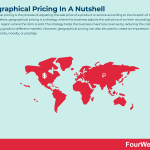

Geographical pricing is the process of adjusting the sale price of a product or service according to the location of the buyer. Therefore, geographical pricing is a strategy where the business adjusts the sale price of an item according to the geographic region where the item is sold. The strategy helps the business maximize revenue by reducing the cost of transporting goods to different markets. However, geographical pricing can also be used to create an impression of regional scarcity, novelty, or prestige.
Understanding geographical pricingGlobal businesses understand that no two markets are the same. The target audience in one region may have vastly different interests or needs compared to the audience from another region. What’s more, there may be a large discrepancy in consumer purchasing power.
Geographical pricing strategies are used by commodities companies, with steel and gasoline the most common examples. Some primary producers also use the strategy, which helps explain why the price of an avocado is cheaper within avocado-growing regions.
Five geographical pricing typesGeographical pricing is a more general phrase that encompasses a range of more concise strategies.
1 – Zone pricingThis is the strategy most associated with geographical pricing. Customers within designated regions are charged the same price for goods and services, with more distant customers charged a higher price.
Zones are typically represented on a map using concentric circles or other boundaries which reflect population density, geography, or transportation infrastructure.
Gasoline prices in the United States are based on a complex mixture of factors including the number of competing stations, transportation corridors, average traffic flow, and the number of vehicles.
2 – Free on Board (FOB) origin pricingHere, the buyer pays for variable shipping costs from the production facility or warehouse.
Ownership of the item transfers to the buyer once the item has left the facility, with the seller or buyer able to arrange the transportation itself.
3 – Basing point pricingIn basing point pricing, certain cities are designed as basing points. Shipping costs from these cities are the same, regardless of whether the buyer lives near the city.
Basing point pricing is common practice in the steel and automotive industries.
4 – Uniform delivered pricingSimilar to basing point pricing is uniform delivered pricing, where buyers pay the same freight costs regardless of their distance from the dispatch location.
The exact freight cost is determined by an average and is typically incorporated into the price of the product.
5 – Freight-absorption pricingFreight-absorption pricing is a strategy where the seller absorbs all or part of the delivery cost to a given region.
This strategy, which is often reserved for when a product is on sale, is essentially a buyer discount because the freight cost is not built into the price.
Other geographical pricing considerationsWhile geographical pricing is mostly driven by shipping cost, there are a couple of other factors that may influence product prices:
Taxation laws – a business may adjust its product pricing based on different sales tax percentages. If Region A has a sales tax of 15% and Region B has a sales tax of 25%, the business will sell its products for a higher price in Region B to offset the extra sales tax.Supply and demand – product pricing may also reflect a supply and demand imbalance in the market. When supply is low in a particular region, prices increase.Consumer purchasing power – those living in rural areas tend to have lower purchasing power than their city counterparts. Purchasing power across different cities also fluctuates, with residents of Zurich and Sydney enjoying more purchasing power than those residing in Manila or Nairobi.Key takeaways:Geographical pricing is the process of adjusting the sale price of a product or service according to the location of the buyer.Geographical pricing types include zone pricing, FOB pricing, basing point pricing, uniform delivered pricing, and freight-absorption pricing.Geographical pricing is mostly driven by consideration for shipping costs. However, region-specific taxation laws, supply and demand, and consumer purchasing power are also key factors.Main Free Guides:
Business ModelsBusiness StrategyBusiness DevelopmentDigital Business ModelsDistribution ChannelsMarketing StrategyPlatform Business ModelsRevenue ModelsTech Business ModelsBlockchain Business Models FrameworkConnected Business Concepts Revenue Modeling Revenue model patterns are a way for companies to monetize their business models. A revenue model pattern is a crucial building block of a business model because it informs how the company will generate short-term financial resources to invest back into the business. Thus, the way a company makes money will also influence its overall business model.Dynamic Pricing
Revenue model patterns are a way for companies to monetize their business models. A revenue model pattern is a crucial building block of a business model because it informs how the company will generate short-term financial resources to invest back into the business. Thus, the way a company makes money will also influence its overall business model.Dynamic Pricing Dynamic pricing is the practice of having multiple price points based on several factors, such as customers segments, peak times of service and time-based consumption that allow the company is applying dynamic pricing to expand its revenue generation.Pricing Strategies
Dynamic pricing is the practice of having multiple price points based on several factors, such as customers segments, peak times of service and time-based consumption that allow the company is applying dynamic pricing to expand its revenue generation.Pricing Strategies A pricing strategy or model helps companies find the pricing formula in fit with their business models. Thus aligning the customer needs with the product type while trying to enable profitability for the company. A good pricing strategy aligns the customer with the company’s long term financial sustainability to build a solid business model. Market Segmentation
A pricing strategy or model helps companies find the pricing formula in fit with their business models. Thus aligning the customer needs with the product type while trying to enable profitability for the company. A good pricing strategy aligns the customer with the company’s long term financial sustainability to build a solid business model. Market Segmentation Market segmentation is the process of dividing the market into sub-groups. Market segmentation can be based on characteristics such as age, behaviors, income levels, and more. This process helps to understand what your key customers want, where they are, and how to talk to them effectively.Customer Segmentation
Market segmentation is the process of dividing the market into sub-groups. Market segmentation can be based on characteristics such as age, behaviors, income levels, and more. This process helps to understand what your key customers want, where they are, and how to talk to them effectively.Customer Segmentation Customer segmentation is a marketing method that divides the customers in sub-groups, that share similar characteristics. Thus, product, marketing and engineering teams can center the strategy from go-to-market to product development and communication around each sub-group. Customer segments can be broken down is several ways, such as demographics, geography, psychographics and more.
Customer segmentation is a marketing method that divides the customers in sub-groups, that share similar characteristics. Thus, product, marketing and engineering teams can center the strategy from go-to-market to product development and communication around each sub-group. Customer segments can be broken down is several ways, such as demographics, geography, psychographics and more.The post What Is Geographical Pricing? Geographical Pricing In A Nutshell appeared first on FourWeekMBA.
Extended Reality: Definition, Use Cases, And Examples
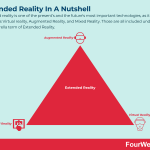

Extended reality is one of the present’s and the future’s most important technologies, as it embraces Virtual reality, Augmented Reality, and Mixed Reality. Those are all included under the umbrella term of Extended Reality.
Virtual RealityVirtual Reality has primarily grown in popularity due to its usage in entertainment, such as video games and immersive movies. However, you may use virtual reality for much more than just to improve the quality of your entertainment.
It is a technology that enables users to engage themselves in a reality that is either completely different from or identical to reality. In other words, it creates a digital reality that takes the place of the user’s physical experience. It uses a head-mounted display to produce a fully realistic experience by replicating as many scenarios as possible.
Augmented RealityTo improve the digital experience, Augmented Reality overlays current reality with various pieces of information. Unlike Virtual Reality, Augmented Reality does not create an altogether new world. Humans can use the cameras on their smartphones and headsets to create an overlay of their real surroundings. This technology is widely used in the gaming business, and it also gets used to improve the presentation of sporting events.
Augmented Reality can be on top of reality because it only adds some qualities and does not change it completely. Moreover, users cannot interact with a simulated environment simultaneously. Augmented Reality technologies are more inexpensive and accessible for private usage because they do not require extra devices such as immersive headsets.
Mixed RealityMixed Reality is probably the least known form of Extended Reality technologies. It incorporates aspects from real and virtual worlds to create a new universe in which actual and synthetic objects coexist. These objects can also interact with each other in real-time.
This sort of reality gets characterized by its flexibility. In addition, it makes the most of Augmented and Virtual Reality. Mixed Reality lets users see the real world alongside certain virtual things anchored to a specific real-world location, allowing them to interact with them as if they were genuine.
The most significant distinction between Mixed Reality and Augmented Reality is the device utilized to interface with the program. Augmented Reality is mostly dependent on mobile devices, whereas Mixed Reality relies on external devices such as smart glasses. As a result, Mixed Reality encourages movement and contact with a mobile phone screen.
Extended RealityExtended Reality encompasses both actual and virtual settings and is concerned with technologically driven human-machine interactions. Because each of the underlying technologies is dependent on each other, advances that result in changes also result in new Extended Reality experiences.
Use Cases of Extended RealityMany businesses all over the world are already taking advantage of the technology. Now let us look at some of the expanding applications of Extended Reality in a few of these areas to understand more about its vast potential.
Entertainment and GamingExtended Reality gets widely used in the entertainment and video game industries. An immersive virtual environment gets created by combining camera tracking and real-time rendering. The capacity of Extended Reality to provide a holistic involvement effect enhances video games. Furthermore, video games are the biggest users of Extended Reality technology, accounting for 76% of usage.
For example, concerts, exhibits, and sporting events can benefit from Augmented Reality, Virtual Reality, and Mixed Reality. People can visit the Louvre museum or watch the World Cup final while sitting at home and feeling immersed in the event, rather than rushing through overcrowded museums or stadiums.
HealthcareInstead of real animals or human bodies, medical students can practice holographically portrayed bodily parts and organs. Not only would this allow for an infinite number of trials, saving real-life body parts that you may utilize for other uses, but it also allows students to improve at home if they are unable to attend their courses physically.
Manufacturing and EngineeringExtended Reality is also being used to learn, work, and train collaboratively in the manufacturing and engineering industries, whether for troubleshooting, practicing routine maintenance processes, or designing to develop something new. You can construct realistic, collaborative, and safe scenarios while simultaneously being remote. Because it is virtually hands-on, training is more engaging than traditional training sessions.
Real EstateExtended Reality enables potential home buyers to obtain a real sense of the property, making it easier for real estate agents and managers to clinch a transaction. It saves time for all parties involved and makes the decision-making process less strenuous.
Architecture and interior design are other examples of Extended Reality in real estate. The system will give specialists and their customers a complete picture of the project, reducing the risk of errors and unpleasant surprises.
TravelExtended Reality is already becoming a necessary component in the travel and tourist industry. Travelers can get more information about their current position by using real-time location tracking in conjunction with cameras that can detect real-life places and sightings. This experience could take the shape of projected videos, objects, or even real-time language translation.
MarketingMarketers can use Extended Reality to give their customers a try-before-you-buy opportunity. It transports them to a certain location, immerses them in that world, and encourages them to discover it.
Advantages and Disadvantages of Extended RealityWith everything said above, it is now time to look at Extended Reality’s Advantages and Disadvantages.
AdvantagesExtended reality enables a unique experience. Companies can provide their consumers with the ability to visit places of interest or try something new without having to leave the house by immersing them in a completely different world.Extended reality allows for a safe training environment. Those who must train in high-risk environments, like the military or engineers, can do so securely in classroom settings.Extended reality makes it possible to absorb knowledge quickly. Extended Reality gives its users a more realistic vision of their subject matter, allowing them to receive more effective training.The use of Extended Reality allows for smooth data access. Because Extended Reality eliminates distance constraints, humans can easily access remote data.DisadvantagesIt reduced social interaction. Extended reality offers a variety of amusements that can entirely immerse human minds and eliminate the need for dialogue. Although Extended Reality allows individuals to communicate, it does it uniquely, excluding face-to-face contact and human engagement.There can be physical injury. Long-term use of Virtual Reality and Augmented Reality glasses might result in eye problems, nausea, lightheadedness, and headaches.The hefty implementation costs. The creation and maintenance of Extended Reality solutions and devices and the gadgets that support this technology are exceedingly costly.ConclusionExtended Reality provides vast opportunities and experiences without needing to go out of your homes. Thousands of businesses have already benefited from Extended Reality. At the same time, Extended Reality deployment, like any other developing technology, is risky and demands a considerable investment.
Read Next: Augmented vs. Virtual Reality, AR Companies, VR Companies, Metaverse, NFT Games, Blockchain in Gaming and Metaverse.
Main Free Guides:
Business ModelsBusiness StrategyBusiness DevelopmentDigital Business ModelsDistribution ChannelsMarketing StrategyPlatform Business ModelsRevenue ModelsTech Business ModelsBlockchain Business Models FrameworkThe post Extended Reality: Definition, Use Cases, And Examples appeared first on FourWeekMBA.
December 29, 2021
What Is The One-For-One Business Model? One-For-One Business Model In A Nutshell
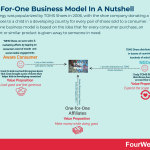

The strategy was popularized by TOMS Shoes in 2006, with the shoe company donating a new pair of shoes to a child in a developing country for every pair of shoes sold to a consumer. The one-for-one business model is based on the idea that for every consumer purchase, an equivalent or similar product is given away to someone in need.
Understanding the one-for-one business modelThe one-for-one model, otherwise known as “buy-one give-one”, is a social entrepreneurship business model in which one item is donated for each item purchased.
Opinions on the one-for-one business model are divided. Proponents suggest it is one way to create more social and commercial value in society, while the most fervent critics claim it is a marketing tactic that exploits the poorest individuals.
Other examples of the one-for-one business modelAfter witnessing the success of TOMS shoes, the model was implemented by many other businesses. These include:
Warby ParkerUnder the Buy a Pair, Give a Pair program, Warby Parker distributes glasses around the world to help people with impaired vision.
 Warby Parker is a prescription and sunglasses retail company, which focuses on vertical integration to enhance the customer experience by owning the optical laboratories where lenses are developed, and by owning both physical and online stores to enable customers to choose from a variety of products. Warby Parker leverages programs like the Home-Try-On program and the “Buy a Pair, Give a Pair” to lower up long-term customer acquisition costs, incentivize recurring purchases and referrals from existing customers. This Bar Saves Lives
Warby Parker is a prescription and sunglasses retail company, which focuses on vertical integration to enhance the customer experience by owning the optical laboratories where lenses are developed, and by owning both physical and online stores to enable customers to choose from a variety of products. Warby Parker leverages programs like the Home-Try-On program and the “Buy a Pair, Give a Pair” to lower up long-term customer acquisition costs, incentivize recurring purchases and referrals from existing customers. This Bar Saves Lives This company aims to fight global hunger by donating a packet of life-saving food with every purchase of a healthy gourmet bar.
The Little Bee Co.With every diaper purchase, the Little Bee Co. donates a cloth diaper to an orphan in need.
Better World BooksThis company is on a mission to improve literacy rates in developing countries. With every book sold under the Book for Book initiative, a book is donated to one of the company’s two partners: Books for Africa and Feed the Children.
FIGSThe one-for-one business model also works in the medical field. FIGS is a provider of comfortable and practical medical wear and donates a clean set of scrubs to healthcare providers who lack the proper attire to do their jobs safely.
Key considerations of one-for-one business modelEntrepreneurs considering the one-for-one business model should note the following key considerations of the approach:
1 – It can boost marketing effortsThe one-for-one-business model is an entire marketing strategy in itself. The next generation of consumers is increasingly choosing to do business with companies that give back to the world.
With 75% of consumers likely to purchase from a company that supports an issue they agree with, it is imperative marketing and product development teams enable the consumer to get what they want and make a positive impact on society at the same time.
2 – It must leverage economies of scaleIn some respects, the one-for-one business model is a balancing act between social good and profitability. In other words, the business must not devote too many resources to producing the donated item.
TOMS made the model work for a time because it utilized cheaper materials and economies of scale through high production volume. But after donating 95 million pairs of shoes in 2019, the company almost went bankrupt and was forced to distance itself from the strategy.
Premium products with lower demand may not be a suitable fit for the one-for-one approach, with some companies choosing to donate a percentage of their total sales to a particular cause. TOMS now donates 33% of its profits to grassroots efforts building local communities from the ground up.
3 – It must consider the recipientsCritics argue that when a company donates items to citizens en masse, they can become dependent on donations instead of contributing to a stronger local business culture or improving their living standards.
While there is nothing inherently wrong with good intentions, one-for-one initiatives should be designed to help people lift themselves out of poverty. Socially responsible companies must also be careful not to undercut the local sellers or producers of the goods they intend to donate.
Key takeaways:The one-for-one business model is based on the idea that for every consumer purchase, an equivalent or similar product is given away to someone in need.The one-for-one business model has been used successfully by companies such as Warby Parker, This Bar Saves Lives, Better World Books, FIGS, and The Little Bee Co. Donated items include books, diapers, medical scrubs, and essential food packets.There are a few key considerations of the one-for-one model. For one, it can enable the business to profit from the next generation of socially responsible consumers. However, the strategy will only work if the business utilizes economies of scale and considers the impact donated items have on the recipient and local producers.Read Next: TOMS Shoes Business Model
Main Free Guides:
Business ModelsBusiness StrategyBusiness DevelopmentDigital Business ModelsDistribution ChannelsMarketing StrategyPlatform Business ModelsRevenue ModelsTech Business ModelsBlockchain Business Models FrameworkThe post What Is The One-For-One Business Model? One-For-One Business Model In A Nutshell appeared first on FourWeekMBA.
NFT Games: What Are NFT Games And How Do They Work?


NFT games are those that incorporate non-fungible tokens (NFT) as a way to drive growth. In essence, NFT games enable developers to monetize their creations while giving users the ability to earn cryptocurrency just by playing the game, what’s known as the play-to-earn business model.
Understanding NFT GamingNFT games use blockchain technology to authenticate unique, in-game collectibles such as characters, avatars, and other items players can collect to assist in their gameplay. Each collectible is an NFT, with smart contracts determining how each function within the game itself. Like all NFTs, the value of a collectible depends on its use or rarity and each can be traded with others in a designated marketplace.
 The play-to-earn model is a business model allowing gamers to farm or collect cryptocurrency and NFTs that can be sold on the market. This model has become a standard already in the “crypto gaming industry,” where the blockchain-based games enable token economics to kick in as an incentives mechanism at scale for users to play and be engaged.
The play-to-earn model is a business model allowing gamers to farm or collect cryptocurrency and NFTs that can be sold on the market. This model has become a standard already in the “crypto gaming industry,” where the blockchain-based games enable token economics to kick in as an incentives mechanism at scale for users to play and be engaged.For the user, NFT games are play-to-earn. This means they are rewarded with more tokens or NFTs the longer they play the game. This model has found particular success with users in developing nations as a viable alternative to a fixed income or social security payment.
With the above in mind, we’ll devote the rest of this article to discussing some of the most popular NFT games available today.
CryptoKittiesOne of the first NFT games to achieve mainstream success was CryptoKitties. Launched on the Ethereum blockchain in 2017, CryptoKitties players collect, breed, and trade digital cats.
Each cat is a unique NFT with smart contracts defining its characteristics, rarity, and ultimate value in the NFT marketplace.
Axie Infinity Axie Infinity is an NFT-based online video game developed by Sky Mavis, a Vietnamese game studio founded by Trung Nguyen in 2018. Nguyen combined his interest in blockchain accountability and the CryptoKitties craze to launch the game in August 2018. Sky Mavis generates the bulk of its revenue via the 4.25% fee it charges on all in-game purchases. This includes land purchases, monster NFT trading, and monster breeding. Axie Infinity requires that all new players purchase three monsters to get started. Since the cost can run into hundreds of dollars, Sky Mavis will lend players the monsters and collect a 30% interest fee once the player starts earning currency.
Axie Infinity is an NFT-based online video game developed by Sky Mavis, a Vietnamese game studio founded by Trung Nguyen in 2018. Nguyen combined his interest in blockchain accountability and the CryptoKitties craze to launch the game in August 2018. Sky Mavis generates the bulk of its revenue via the 4.25% fee it charges on all in-game purchases. This includes land purchases, monster NFT trading, and monster breeding. Axie Infinity requires that all new players purchase three monsters to get started. Since the cost can run into hundreds of dollars, Sky Mavis will lend players the monsters and collect a 30% interest fee once the player starts earning currency.Axie Infinity is an NFT game based on the metaverse, where players can collect, raise, and battle with NFT creatures known as Axies. Some consider the game to be the NFT equivalent of Pokémon.
Axie Infinity requires that new users purchase three Axies in the marketplace before they can participate in the game. With the cost of NFT monsters climbing in recent times, users have created an informal market where “managers” rent out their monsters to “scholars” and take a cut of any subsequent rewards.
The metaverse governance token AXS is used to breed Axies and had a market capitalization of approximately $7 billion at the time of writing.
SplinterlandsLaunched in 2018, Splinterlands is a card-based strategy game operating on the Hive blockchain. With approximately 520,000 active users, Splinterlands is the most popular NFT game on the market.
Splinterlands is a collectible trading-card-based game. Each card represents a monster with various unique stats and abilities, with users able to battle others and win rewards. The game recently released the Splintershards (SPS) cryptocurrency governance token to provide an increased level of decision-making ability and control for the user base and asset owners.
Alien WorldsAlien Worlds is a more recent NFT game having only been launched in December 2020. It is another metaverse game in which players stake the Trilium (TLM) game token to lease spacecraft, travel on missions, vote in elections, and run for planetary council.
Players may select NFT game cards for their strategy on the Binance Smart Chain (BSC) and WAX carbon-neutral blockchain, with these cards able to be used for mining and fighting, among other things.
CryptoMinesCryptoMines is a science fiction NFT game released in September 2021. Like Alien Worlds, it is based on the Binance Smart Chain, and users are required to travel through space in search of rewards that help them extend the lives of their characters and make a profit from playing.
Workers and spaceships are NFTs minted in the ERC-721 standard for representing ownership of non-fungible tokens. Players can also stake the reward token ETERNAL in a liquidity pool with the potential to increase the value of their holdings.
Key takeaways:NFT games are those that incorporate non-fungible tokens (NFT) as a way to drive growth. In essence, these games enable developers to monetize their creations while giving users the ability to earn cryptocurrency just by playing the game.CryptoKitties was one of the first NFT games to achieve relative success. Today, Splinterlands is the largest NFT game which over half a million active users.Alien Worlds and CryptoMines are NFT games based on the Binance Smart Chain, requiring users to travel through space in search of rewards. Metaverse game Axie Infinity requires users to collect and battle monsters in a way similar to Pokemon.Get The 450 Pages Blockchain Business Models Book

Read Also: Gaming Industry, Epic Games Business Model, Free-To-Play, Proof-of-stake, Proof-of-work, Bitcoin, Dogecoin, Ethereum, Solana, Blockchain, BAT, Monero, Ripple, Litecoin, Stellar, Dogecoin, Bitcoin Cash, Filecoin.
Main Free Guides:
Business ModelsBusiness StrategyBusiness DevelopmentDigital Business ModelsDistribution ChannelsMarketing StrategyPlatform Business ModelsRevenue ModelsTech Business ModelsBlockchain Business Models FrameworkConnected Business Concepts to NFT Games EA Sports is among the largest gaming publishers, with a hybrid strategy of fully-owned games and licensed games distributed with a cross-platform approach. FIFA is the game that most contributes to its revenues and live services (Ultimate Team in particular) are the largest revenue contributors to EA revenues.
EA Sports is among the largest gaming publishers, with a hybrid strategy of fully-owned games and licensed games distributed with a cross-platform approach. FIFA is the game that most contributes to its revenues and live services (Ultimate Team in particular) are the largest revenue contributors to EA revenues. The gaming industry, part of the entertainment industry, is comprised of three main types of players. From game engines, which help developers build their games. To publishing gaming houses. And gaming consoles. While the prevailing business model for decades has been that of selling the console at cost, and make money on games. Digital games changed the way games are distributed and sold, and it opened up the way to free-to-play models.
The gaming industry, part of the entertainment industry, is comprised of three main types of players. From game engines, which help developers build their games. To publishing gaming houses. And gaming consoles. While the prevailing business model for decades has been that of selling the console at cost, and make money on games. Digital games changed the way games are distributed and sold, and it opened up the way to free-to-play models. Roblox is an online gaming platform where users can create avatars and explore various gaming experiences. Each experience will be monetized based on how its developer has structured the game. For instance, free games allow users to spend the platform’s currency, called Robux, to get specific enhancements or purchase items like clothing accessories for the avatars, simulated gestures from the Roblox Avatar Marketplace. Therefore, Roblox makes money by earning a commission on each transaction and through its internal ad network.
Roblox is an online gaming platform where users can create avatars and explore various gaming experiences. Each experience will be monetized based on how its developer has structured the game. For instance, free games allow users to spend the platform’s currency, called Robux, to get specific enhancements or purchase items like clothing accessories for the avatars, simulated gestures from the Roblox Avatar Marketplace. Therefore, Roblox makes money by earning a commission on each transaction and through its internal ad network. Tencent is a Chinese multinational conglomerate founded in 1998 by Ma Huateng, Zhang Zhidong, and Xu Chenye. Among its various global subsidiaries are companies in the online services, music, and artificial intelligence industries. But it is perhaps best known for its interest in the video game sector – both as a game developer for the Chinese market and the acquirer of several established gaming companies. Tencent is a vast company with a stake in more than 600 companies. Following is a look at some of the companies and subsidiaries it has a majority stake in.
Tencent is a Chinese multinational conglomerate founded in 1998 by Ma Huateng, Zhang Zhidong, and Xu Chenye. Among its various global subsidiaries are companies in the online services, music, and artificial intelligence industries. But it is perhaps best known for its interest in the video game sector – both as a game developer for the Chinese market and the acquirer of several established gaming companies. Tencent is a vast company with a stake in more than 600 companies. Following is a look at some of the companies and subsidiaries it has a majority stake in. A free-to-play is a model that became particularly popular in gaming. Free-to-play is also commonly referred to as free-to-start. For instance, companies like Epic Games have launched popular games like Fortnite’s Battle Royale, which had ingrained a free-to-play model. This is a model that become extremely popular in the digital age of gaming.
A free-to-play is a model that became particularly popular in gaming. Free-to-play is also commonly referred to as free-to-start. For instance, companies like Epic Games have launched popular games like Fortnite’s Battle Royale, which had ingrained a free-to-play model. This is a model that become extremely popular in the digital age of gaming. According to Joel Monegro, a former analyst at USV (a venture capital firm) the blockchain implies value creation in its protocols. Where the web has allowed the value to be captured at the applications layer (take Facebook, Twitter, Google, and many others). In a Blockchain Economy, this value might be captured by the protocols at the base of the blockchain (for instance Bitcoin and Ethereum). However, according to blockchain investor Paivinen due to ease of forking, incentives to compete and improved interoperability and interchangeability also in a blockchain-based economy, protocols might get thinner. Although the marginal value of scale might be lower compared to a web-based economy, where massive scale created an economic advantage. The success of the Blockchain will depend on its commercial viability!
According to Joel Monegro, a former analyst at USV (a venture capital firm) the blockchain implies value creation in its protocols. Where the web has allowed the value to be captured at the applications layer (take Facebook, Twitter, Google, and many others). In a Blockchain Economy, this value might be captured by the protocols at the base of the blockchain (for instance Bitcoin and Ethereum). However, according to blockchain investor Paivinen due to ease of forking, incentives to compete and improved interoperability and interchangeability also in a blockchain-based economy, protocols might get thinner. Although the marginal value of scale might be lower compared to a web-based economy, where massive scale created an economic advantage. The success of the Blockchain will depend on its commercial viability! A Proof of Stake (PoS) is a form of consensus algorithm used to achieve agreement across a distributed network. As such it is, together with Proof of Work, among the key consensus algorithms for Blockchain protocols (like the Ethereum’s Casper protocol). Proof of Stake has the advantage of security, reduced risk of centralization, and energy efficiency.
A Proof of Stake (PoS) is a form of consensus algorithm used to achieve agreement across a distributed network. As such it is, together with Proof of Work, among the key consensus algorithms for Blockchain protocols (like the Ethereum’s Casper protocol). Proof of Stake has the advantage of security, reduced risk of centralization, and energy efficiency. A Proof of Work is a form of consensus algorithm used to achieve agreement across a distributed network. In a Proof of Work, miners compete to complete transactions on the network, by commuting hard mathematical problems (i.e. hashes functions) and as a result they get rewarded in coins.
A Proof of Work is a form of consensus algorithm used to achieve agreement across a distributed network. In a Proof of Work, miners compete to complete transactions on the network, by commuting hard mathematical problems (i.e. hashes functions) and as a result they get rewarded in coins.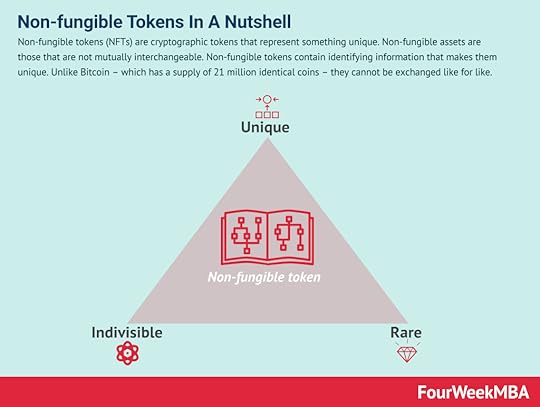 Non-fungible tokens (NFTs) are cryptographic tokens that represent something unique. Non-fungible assets are those that are not mutually interchangeable. Non-fungible tokens contain identifying information that makes them unique. Unlike Bitcoin – which has a supply of 21 million identical coins – they cannot be exchanged like for like.
Non-fungible tokens (NFTs) are cryptographic tokens that represent something unique. Non-fungible assets are those that are not mutually interchangeable. Non-fungible tokens contain identifying information that makes them unique. Unlike Bitcoin – which has a supply of 21 million identical coins – they cannot be exchanged like for like. A Blockchain Business Model according to the FourWeekMBA framework is made of four main components: Value Model (Core Philosophy, Core Values and Value Propositions for the key stakeholders), Blockchain Model (Protocol Rules, Network Shape and Applications Layer/Ecosystem), Distribution Model (the key channels amplifying the protocol and its communities), and the Economic Model (the dynamics/incentives through which protocol players make money). Those elements coming together can serve as the basis to build and analyze a solid Blockchain Business Model.
A Blockchain Business Model according to the FourWeekMBA framework is made of four main components: Value Model (Core Philosophy, Core Values and Value Propositions for the key stakeholders), Blockchain Model (Protocol Rules, Network Shape and Applications Layer/Ecosystem), Distribution Model (the key channels amplifying the protocol and its communities), and the Economic Model (the dynamics/incentives through which protocol players make money). Those elements coming together can serve as the basis to build and analyze a solid Blockchain Business Model. Ethereum was launched in 2015 with its cryptocurrency, Ether, as an open-source, blockchain-based, decentralized platform software. Smart contracts are enabled, and Distributed Applications (dApps) get built without downtime or third-party disturbance. It also helps developers build and publish applications as it is also a programming language running on a blockchain.
Ethereum was launched in 2015 with its cryptocurrency, Ether, as an open-source, blockchain-based, decentralized platform software. Smart contracts are enabled, and Distributed Applications (dApps) get built without downtime or third-party disturbance. It also helps developers build and publish applications as it is also a programming language running on a blockchain.The post NFT Games: What Are NFT Games And How Do They Work? appeared first on FourWeekMBA.
What Is Micromarketing? Micromarketing In A Nutshell


Micromarketing is a marketing strategy that is used to advertise a product or service with a narrow customer base. Micromarketing is a strategy businesses use to target a small subsection of their user base. These subsections are defined by specific customer traits, including location, age, interests, household income, occupation, and price sensitivity.
Understanding micromarketing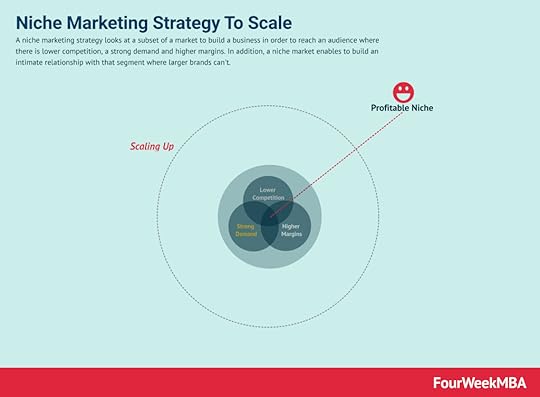
Micromarketing most often describes marketing strategies that are customized according to an individual customer, but they can also be customized to a local market or market segment. The strategy itself became popular in the 1990s as mass uptake of the personal computer made it easier for businesses to segment customers and send them information.
Micromarketing is seen as a worthwhile strategy to address the hypercompetitive nature of modern marketplaces. Indeed, consumers prefer to purchase products they feel were developed by businesses to solve specific and sometimes very personal problems.
Micromarketing examples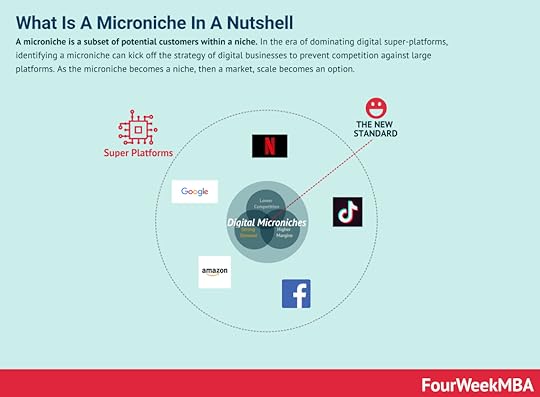 A microniche is a subset of potential customers within a niche. In the era of dominating digital super-platforms, identifying a microniche can kick off the strategy of digital businesses to prevent competition against large platforms. As the microniche becomes a niche, then a market, scale becomes an option.
A microniche is a subset of potential customers within a niche. In the era of dominating digital super-platforms, identifying a microniche can kick off the strategy of digital businesses to prevent competition against large platforms. As the microniche becomes a niche, then a market, scale becomes an option.Let’s now take a look at some micromarketing examples:
Red BullIn truth, the popular energy drink Red Bull appeals to a broad range of consumers. But the company choose to associate the beverage with extreme sports competitions where it was marketed to a specific group of young male participants in need of an energy boost.
Binaural microphones3Dio is a family-owned business that makes binaural microphones, which are microphones with a human ear molded to each side. These microphones were developed for a niche community of people who create ASMR (autonomous sensory meridian response) content on YouTube and similar platforms.
Coca-ColaNo article on micromarketing would be complete without mentioning the Share a Coke campaign. Here, the beverage giant replaced the Coca-Cola label on their 20-ounce bottles with various first names. Before developing the campaign, the company analyzed what names would sell the most according to their customer base. This personal touch became a huge success for Coca-Cola, reporting 19% year-over-year sales growth for the 20-ounce bottle the year after the campaign was launched.
Advantages and disadvantages of micromarketingThe most obvious advantage of a micromarketing strategy is that it is highly targeted. With that in mind, here are some less obvious advantages:
Reduced costsMicromarketing reduces costs because the target audience is smaller than one seen in a traditional marketing campaign.
Brand awarenessWhen a business becomes hyper-specific about the type of customer it wants to attract, there is an increased likelihood the customer will become enamored with the brand and tell their friends and family.
Less competitionMicromarketing can be used in conjunction with the long tail strategy, where retailers sell many unique items with relatively smaller quantities sold of each. These niche products tend to have less competition since most retailers prefer to sell popular, high-volume goods.
Let’s now take a look at some of the disadvantages:
Time-intensiveSelecting a narrow and defined market or audience segment requires detailed and thus time-intensive research. Marketing campaigns may also need to be developed for each segment.
Customer acquisition costsSince the segment comprises fewer people, the average cost of acquiring a new customer is higher. There is a possibility that increased customer acquisition costs negate the cost-saving from targeting a smaller audience in the first place.
Ineffective campaignsIn some cases the marketing effort may be ineffective. With such a narrow band of consumers targeted, a poorly researched campaign will not be relevant to other, more profitable segments by default.
Key takeaways:Micromarketing is a marketing strategy that is used to advertise a product or service with a narrow customer base. Micromarketing strategies are customized according to the individual customer, local market, or market segment.Micromarketing has been employed successfully by companies such as Coca-Cola, Red Bull, and 3Dio.Micromarketing reduces costs, increases brand awareness, and encourages businesses to target less competitive niche products. However, the strategy can be time-intensive and is associated with higher customer acquisition costs. The ultra-specific nature of micromarketing may also cause some businesses to target the wrong audience.Types Of Marketing Connected To Micromarketing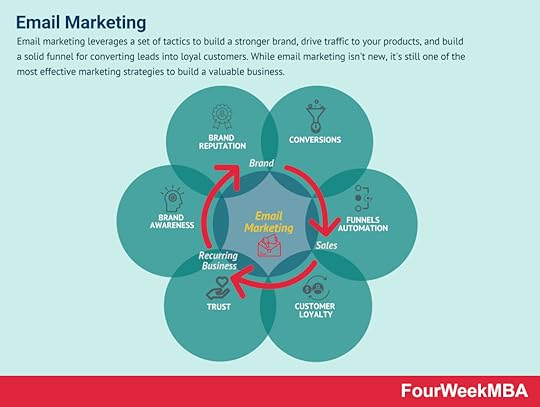 Email marketing leverages a set of tactics to build a stronger brand, drive traffic to your products, and build a solid funnel for converting leads into loyal customers. While email marketing isn’t new, it’s still one of the most effective marketing strategies to build a valuable business.
Email marketing leverages a set of tactics to build a stronger brand, drive traffic to your products, and build a solid funnel for converting leads into loyal customers. While email marketing isn’t new, it’s still one of the most effective marketing strategies to build a valuable business.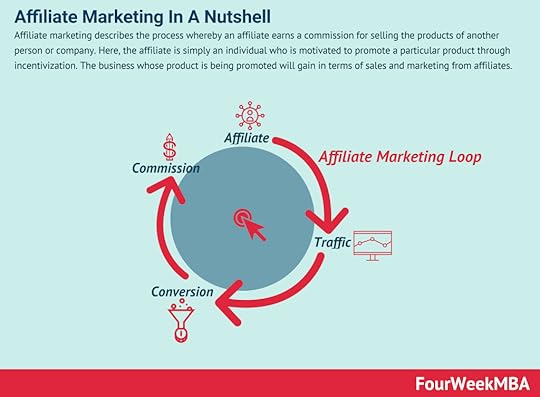 Affiliate marketing describes the process whereby an affiliate earns a commission for selling the products of another person or company. Here, the affiliate is simply an individual who is motivated to promote a particular product through incentivization. The business whose product is being promoted will gain in terms of sales and marketing from affiliates.
Affiliate marketing describes the process whereby an affiliate earns a commission for selling the products of another person or company. Here, the affiliate is simply an individual who is motivated to promote a particular product through incentivization. The business whose product is being promoted will gain in terms of sales and marketing from affiliates.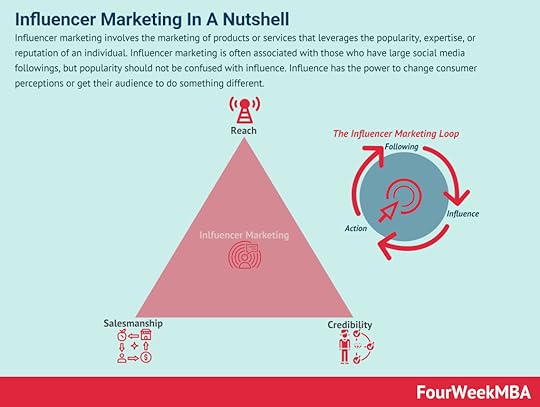 Influencer marketing involves the marketing of products or services that leverages the popularity, expertise, or reputation of an individual. Influencer marketing is often associated with those who have large social media followings, but popularity should not be confused with influence. Influence has the power to change consumer perceptions or get their audience to do something different.
Influencer marketing involves the marketing of products or services that leverages the popularity, expertise, or reputation of an individual. Influencer marketing is often associated with those who have large social media followings, but popularity should not be confused with influence. Influence has the power to change consumer perceptions or get their audience to do something different.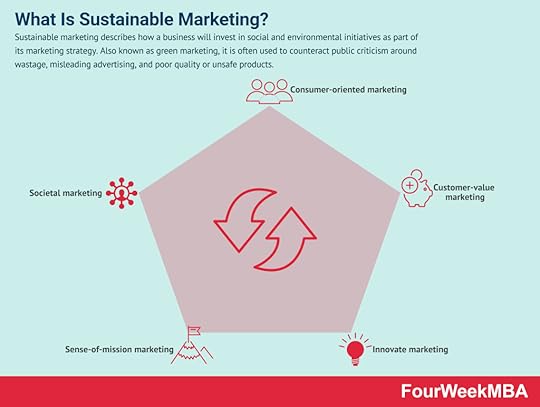 Sustainable marketing describes how a business will invest in social and environmental initiatives as part of its marketing strategy. Also known as green marketing, it is often used to counteract public criticism around wastage, misleading advertising, and poor quality or unsafe products.
Sustainable marketing describes how a business will invest in social and environmental initiatives as part of its marketing strategy. Also known as green marketing, it is often used to counteract public criticism around wastage, misleading advertising, and poor quality or unsafe products.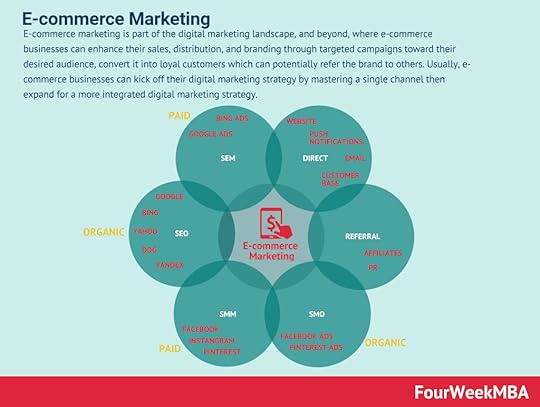 E-commerce marketing is part of the digital marketing landscape, and beyond, where e-commerce businesses can enhance their sales, distribution, and branding through targeted campaigns toward their desired audience, convert it into loyal customers which can potentially refer the brand to others. Usually, e-commerce businesses can kick off their digital marketing strategy by mastering a single channel then expand for a more integrated digital marketing strategy.
E-commerce marketing is part of the digital marketing landscape, and beyond, where e-commerce businesses can enhance their sales, distribution, and branding through targeted campaigns toward their desired audience, convert it into loyal customers which can potentially refer the brand to others. Usually, e-commerce businesses can kick off their digital marketing strategy by mastering a single channel then expand for a more integrated digital marketing strategy. Buzz marketing leverages the power of word-of-mouth advertising to create products or services with enough novelty that they go viral. In many cases, buzz marketing leverages on versatile content that can easily scale and be readapted to various contexts and fear of missing out (FOMO) to amplify the effect of word-of-mouth campaigns.
Buzz marketing leverages the power of word-of-mouth advertising to create products or services with enough novelty that they go viral. In many cases, buzz marketing leverages on versatile content that can easily scale and be readapted to various contexts and fear of missing out (FOMO) to amplify the effect of word-of-mouth campaigns.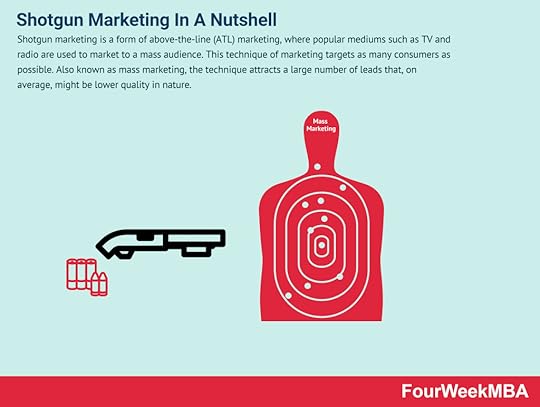 Shotgun marketing is a form of above-the-line (ATL) marketing, where popular mediums such as TV and radio are used to market to a mass audience. This technique of marketing targets as many consumers as possible. Also known as mass marketing, the technique attracts a large number of leads that, on average, might be of lower quality in nature.
Shotgun marketing is a form of above-the-line (ATL) marketing, where popular mediums such as TV and radio are used to market to a mass audience. This technique of marketing targets as many consumers as possible. Also known as mass marketing, the technique attracts a large number of leads that, on average, might be of lower quality in nature.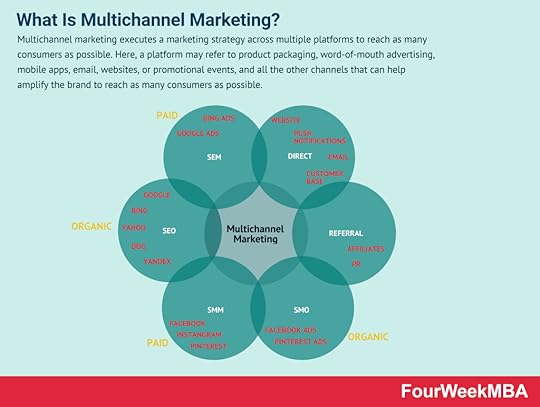 Multichannel marketing executes a marketing strategy across multiple platforms to reach as many consumers as possible. Here, a platform may refer to product packaging, word-of-mouth advertising, mobile apps, email, websites, or promotional events, and all the other channels that can help amplify the brand to reach as many consumers as possible.
Multichannel marketing executes a marketing strategy across multiple platforms to reach as many consumers as possible. Here, a platform may refer to product packaging, word-of-mouth advertising, mobile apps, email, websites, or promotional events, and all the other channels that can help amplify the brand to reach as many consumers as possible.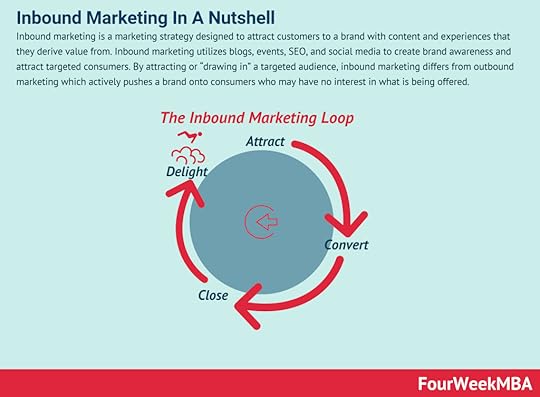 Inbound marketing is a marketing strategy designed to attract customers to a brand with content and experiences that they derive value from. Inbound marketing utilizes blogs, events, SEO, and social media to create brand awareness and attract targeted consumers. By attracting or “drawing in” a targeted audience, inbound marketing differs from outbound marketing which actively pushes a brand onto consumers who may have no interest in what is being offered.
Inbound marketing is a marketing strategy designed to attract customers to a brand with content and experiences that they derive value from. Inbound marketing utilizes blogs, events, SEO, and social media to create brand awareness and attract targeted consumers. By attracting or “drawing in” a targeted audience, inbound marketing differs from outbound marketing which actively pushes a brand onto consumers who may have no interest in what is being offered. With partnership marketing, two or more companies team up to create marketing campaigns that help them grow organically with a mutual agreement, thus making it possible to reach shared business goals. Partnership marketing leverages time and resources of partners that help them expand their market.
With partnership marketing, two or more companies team up to create marketing campaigns that help them grow organically with a mutual agreement, thus making it possible to reach shared business goals. Partnership marketing leverages time and resources of partners that help them expand their market.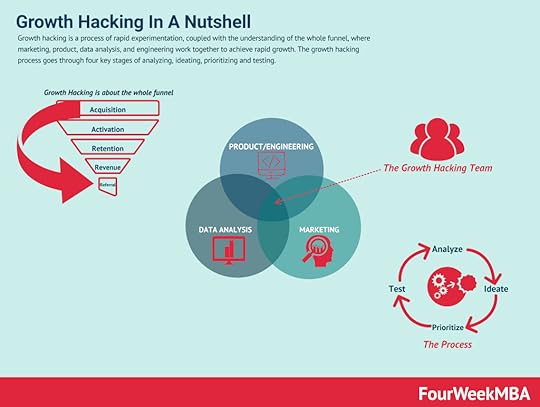 Growth marketing is a process of rapid experimentation, which in a way has to be “scientific” by keeping in mind that it is used by startups to grow, quickly. Thus, the “scientific” here is not meant in the academic sense. Growth marketing is expected to unlock growth, quickly and with an often limited budget.
Growth marketing is a process of rapid experimentation, which in a way has to be “scientific” by keeping in mind that it is used by startups to grow, quickly. Thus, the “scientific” here is not meant in the academic sense. Growth marketing is expected to unlock growth, quickly and with an often limited budget.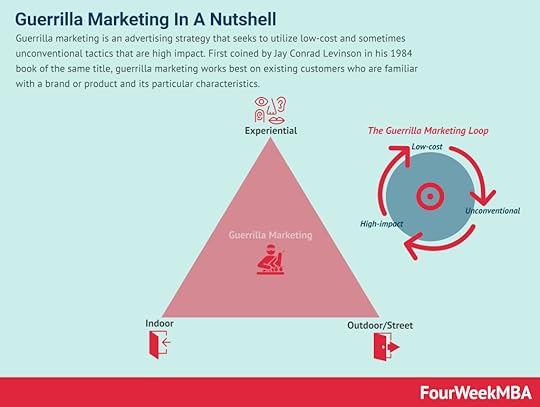 Guerrilla marketing is an advertising strategy that seeks to utilize low-cost and sometimes unconventional tactics that are high impact. First coined by Jay Conrad Levinson in his 1984 book of the same title, guerrilla marketing works best on existing customers who are familiar with a brand or product and its particular characteristics.
Guerrilla marketing is an advertising strategy that seeks to utilize low-cost and sometimes unconventional tactics that are high impact. First coined by Jay Conrad Levinson in his 1984 book of the same title, guerrilla marketing works best on existing customers who are familiar with a brand or product and its particular characteristics.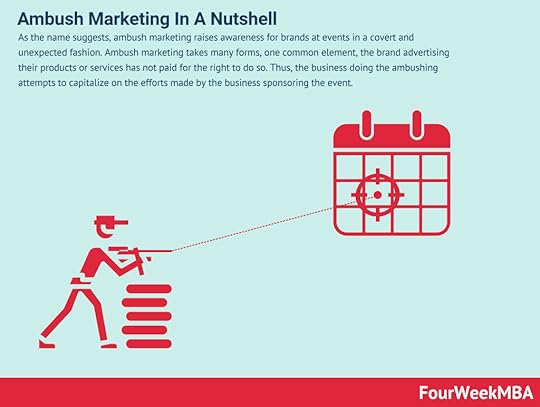 As the name suggests, ambush marketing raises awareness for brands at events in a covert and unexpected fashion. Ambush marketing takes many forms, one common element, the brand advertising their products or services has not paid for the right to do so. Thus, the business doing the ambushing attempts to capitalize on the efforts made by the business sponsoring the event.
As the name suggests, ambush marketing raises awareness for brands at events in a covert and unexpected fashion. Ambush marketing takes many forms, one common element, the brand advertising their products or services has not paid for the right to do so. Thus, the business doing the ambushing attempts to capitalize on the efforts made by the business sponsoring the event. Relationship marketing involves businesses and their brands forming long-term relationships with customers. The focus of relationship marketing is to increase customer loyalty and engagement through high-quality products and services. It differs from short-term processes focused solely on customer acquisition and individual sales.
Relationship marketing involves businesses and their brands forming long-term relationships with customers. The focus of relationship marketing is to increase customer loyalty and engagement through high-quality products and services. It differs from short-term processes focused solely on customer acquisition and individual sales.Main Free Guides:
Business ModelsBusiness CompetitionBusiness StrategyBusiness DevelopmentDigital Business ModelsDistribution ChannelsMarketing StrategyPlatform Business ModelsRevenue ModelsTech Business ModelsBlockchain Business Models FrameworkThe post What Is Micromarketing? Micromarketing In A Nutshell appeared first on FourWeekMBA.
What Is Micro-Investing? Micro-Investing In A Nutshell
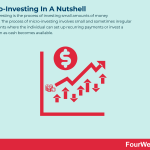

Micro-investing is the process of investing small amounts of money regularly. The process of micro-investing involves small and sometimes irregular investments where the individual can set up recurring payments or invest a lump sum as cash becomes available.
Understanding micro-investingBefore there was such a thing as a digital transaction, consumers looking to save their spare change may have used a piggy bank. As cash becomes obsolete, however, many consider micro-investing to be a viable modern-day alternative.
Micro-investing is a passive solution designed to make investing simple and accessible for beginners. Most can get started with as little as $5 invested into a diversified portfolio.
The process of micro-investing involves small and sometimes irregular investments. The individual can set up recurring payments or invest a lump sum as cash becomes available. Some micro-investing platforms will also allow the user to round up a transaction to the nearest dollar and invest the difference. For instance, the purchase of a coffee for $3.75 would be rounded up to $4 with the remaining 25 cents invested.
With interest rates at historic lows, micro-investing can generate a better return than if the funds were to sit idle in a standard savings account.
The main micro-investing platformsThere are many micro-investing platforms on the market today, with most removing or at least reducing the barriers to traditional investing such as brokerage fees, management fees, and minimum investment amounts.
Some of the most popular micro-investing platforms include:
Acorns Acorns is a fintech platform providing services related to Robo-investing and micro-investing. The company makes money primarily through three subscription tiers: Lite – ($1/month), which gives users access to Acorns Invest, Personal ($3/month) that includes Invest plus the Later (retirement) and Spend (personal checking account) suite of products, Family ($5/month) with features from both the Lite and Personal plans with the addition of Early.
Acorns is a fintech platform providing services related to Robo-investing and micro-investing. The company makes money primarily through three subscription tiers: Lite – ($1/month), which gives users access to Acorns Invest, Personal ($3/month) that includes Invest plus the Later (retirement) and Spend (personal checking account) suite of products, Family ($5/month) with features from both the Lite and Personal plans with the addition of Early. A mobile app that rounds up the spare change from daily purchases and invests the remainder into a diversified portfolio of exchange-traded funds (ETFs), bonds, indexes, and even Bitcoin. Users can choose a portfolio based on their risk appetite and there is no fee for depositing or withdrawing funds from the platform.
Public.comA commission-free micro-investing platform for Millennial and Generation Z consumers that incorporates aspects of social media. Public.com users can own fractional shares in stocks and ETFs, follow popular creators, and discuss strategies with a community of like-minded others.
M1 Finance M1 Finance is a North American online trading platform for common and preferred stocks and exchange-traded funds (ETFs). The company also offers margin lending, cash management, and a checking or debit account service. M1 Finance has a standard assortment of revenue streams for an investment platform. As a market maker earns money on the bid-ask spread, M1 Finance also offers a single premium subscription dubbed M1 Plus, and through interest and interchange fees.
M1 Finance is a North American online trading platform for common and preferred stocks and exchange-traded funds (ETFs). The company also offers margin lending, cash management, and a checking or debit account service. M1 Finance has a standard assortment of revenue streams for an investment platform. As a market maker earns money on the bid-ask spread, M1 Finance also offers a single premium subscription dubbed M1 Plus, and through interest and interchange fees. A micro-investing platform that also serves as a robo-advisor. M1 Finance is an automated solution that invests on a user’s behalf and will also rebalance a portfolio based on preconfigured asset allocation targets.
Spaceship VoyagerAnother robo-advisor platform that lets the user transfer small amounts into three portfolio options comprised of some of the world’s most innovative and socially responsible companies. Spaceship Voyager charges a flat monthly fee with no additional charge for a customer holding multiple portfolios.
Robinhood Robinhood is an app that helps to invest in stocks, ETFs, options, and cryptocurrencies, all commission-free. Robinhood earns money by offering: Robinhood Gold, a margin trading service, which starts at $6 a month, earn interests from customer cash and stocks, and rebates from market makers and trading venues.
Robinhood is an app that helps to invest in stocks, ETFs, options, and cryptocurrencies, all commission-free. Robinhood earns money by offering: Robinhood Gold, a margin trading service, which starts at $6 a month, earn interests from customer cash and stocks, and rebates from market makers and trading venues.One of the first micro-investing platforms launched in 2013. The app was designed to be as intuitive as possible with no bells and whistles or confusing terminology. For the more hands-on micro- investor, Robinhood provides real-time market data and also allows Bitcoin trading.
Key takeaways:Micro-investing is the process of investing small amounts of money regularly.Micro-investing can occur via a recurring or lump sum payment. Many platforms also allow customers to round up day-to-day transactions to the nearest dollar and invest the difference automatically.Micro-investing platforms include Acorns, Public.com, M1 Finance, Spaceship Voyager, and Robinhood. Most were designed to remove the barriers associated with traditional investing, such as brokerage fees, fund management fees, and minimum investment amounts.Main Free Guides:
Business ModelsBusiness CompetitionBusiness StrategyBusiness DevelopmentDigital Business ModelsDistribution ChannelsMarketing StrategyPlatform Business ModelsRevenue ModelsTech Business ModelsBlockchain Business Models FrameworkConnected Concepts To Micro-InvestingBusiness Incubator A business incubator is an organization that helps start-up companies or entrepreneurs develop their businesses. Assistance usually takes the form of dedicated office space, management training, and venture capital funding. According to the National Business Incubation Association, there are more than 1,400 incubators in the United States.Angel Investing
A business incubator is an organization that helps start-up companies or entrepreneurs develop their businesses. Assistance usually takes the form of dedicated office space, management training, and venture capital funding. According to the National Business Incubation Association, there are more than 1,400 incubators in the United States.Angel Investing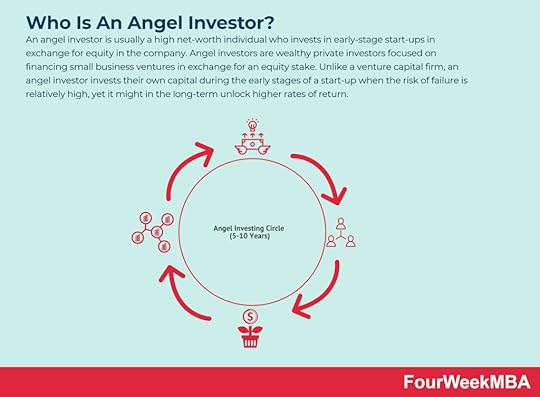 An angel investor is usually a high net-worth individual who invests in early-stage start-ups in exchange for equity in the company. Angel investors are wealthy private investors focused on financing small business ventures in exchange for an equity stake. Unlike a venture capital firm, an angel investor invests their own capital during the early stages of a start-up when the risk of failure is relatively high, yet it might in the long-term unlock higher rates of return. Venture Capital
An angel investor is usually a high net-worth individual who invests in early-stage start-ups in exchange for equity in the company. Angel investors are wealthy private investors focused on financing small business ventures in exchange for an equity stake. Unlike a venture capital firm, an angel investor invests their own capital during the early stages of a start-up when the risk of failure is relatively high, yet it might in the long-term unlock higher rates of return. Venture Capital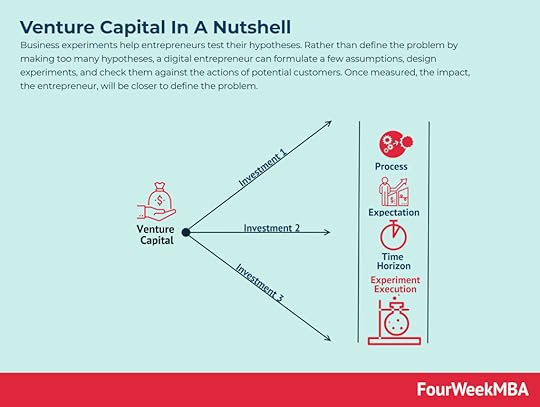 A venture capitalist generally invests in companies and startups which are still in a stage where their business model needs to be proved viable, or they need resources to scale up. Thus, those companies present high risks, but the potential for exponential growth. Therefore, venture capitalists look for startups that can bring a high ROI and high valuation multiples.Economic Moat
A venture capitalist generally invests in companies and startups which are still in a stage where their business model needs to be proved viable, or they need resources to scale up. Thus, those companies present high risks, but the potential for exponential growth. Therefore, venture capitalists look for startups that can bring a high ROI and high valuation multiples.Economic Moat Economic or market moats represent the long-term business defensibility. Or how long a business can retain its competitive advantage in the marketplace over the years. Warren Buffet who popularized the term “moat” referred to it as a share of mind, opposite to market share, as such it is the characteristic that all valuable brands have.Meme Investing
Economic or market moats represent the long-term business defensibility. Or how long a business can retain its competitive advantage in the marketplace over the years. Warren Buffet who popularized the term “moat” referred to it as a share of mind, opposite to market share, as such it is the characteristic that all valuable brands have.Meme Investing Meme stocks are securities that go viral online and attract the attention of the younger generation of retail investors. Meme investing, therefore, is a bottom-up, community-driven approach to investing that positions itself as the antonym to Wall Street investing. Also, meme investing often looks at attractive opportunities with lower liquidity that might be easier to overtake, thus enabling wide speculation, as “meme investors” often look for disproportionate short-term returns.Payment for Order Flow
Meme stocks are securities that go viral online and attract the attention of the younger generation of retail investors. Meme investing, therefore, is a bottom-up, community-driven approach to investing that positions itself as the antonym to Wall Street investing. Also, meme investing often looks at attractive opportunities with lower liquidity that might be easier to overtake, thus enabling wide speculation, as “meme investors” often look for disproportionate short-term returns.Payment for Order Flow Payment for order flow consists of a “kickback” or commission that the broker routing customers to a market maker (in charge of enabling the bid and ask price) will pay a commission to the broker as a sort of market-making fee.What is a SPAC
Payment for order flow consists of a “kickback” or commission that the broker routing customers to a market maker (in charge of enabling the bid and ask price) will pay a commission to the broker as a sort of market-making fee.What is a SPAC A special purpose acquisition company (SPAC) is a company with no commercial operations that are created to raise capital through an IPO to acquire another company. The SPAC is also called for that reason a “blank check company” as it will use the money provided by investors to enable private companies to go public via the SPAC.
A special purpose acquisition company (SPAC) is a company with no commercial operations that are created to raise capital through an IPO to acquire another company. The SPAC is also called for that reason a “blank check company” as it will use the money provided by investors to enable private companies to go public via the SPAC.The post What Is Micro-Investing? Micro-Investing In A Nutshell appeared first on FourWeekMBA.
What Is The Low-Touch Business Model? The Low-Touch Business Model In A Nutshell
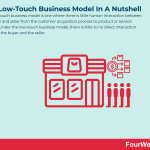

The low-touch business model is one where there is little human interaction between the buyer and seller from the customer acquisition process to product or service delivery. Under the low-touch business model, there is little to no direct interaction between the buyer and the seller.
Understanding the low-touch business modelSince automation and digital sales are important components of the business model, it is popular with eCommerce platforms where products are offered with a direct checkout option. When there is interaction on an eCommerce site, it commonly occurs via live digital assistants or chatbots. Indeed, most buyers are not motivated to interact with a company unless they have a pressing issue such as a warranty claim or customer complaint, which makes this business model low-touch as opposed to “no-touch”.
The automated nature of the low-touch business model can also be seen in situations that pre-date the internet, such as withdrawing cash from an automatic teller machine (ATM) and filling the car with gas from a self-service pump.
The three stages of the low-touch business modelEvery application of the low-touch business model will be different, but most incorporate three general stages.
1 – Customer awarenessModern low-touch businesses utilize digital and content marketing strategies delivered via the company website, blog, or email address. Some others may use videos, webinars, or any other automated solution that minimizes costs.
Email marketing is considered particularly advantageous because of the way it can be used across multiple customer touchpoints.
Whatever the strategy chosen, the primary focus during this stage is to get ultra-specific on a target audience or buyer persona and focus on adding value to the channels where these individuals spend their time. Ultimately, the automated communication of the low-touch business model is only successful if it is backed by a deep understanding of the ideal prospect.
2 – Customer evaluation and qualifyingFor products with low profit margins, a buyer may peruse the item description or consumer reviews before making a direct purchase. Sellers of premium products or those offering software-as-a-service (SaaS) may entice buyers with an automated free trial or access to a freemium version.
In either case, the in-product experience should be maximized to encourage the prospect to purchase after the free period has ended. This means delivering value as quickly as possible to reduce customer churn rate and increase customer retention.
3 – Purchase and after-salesConsumers now expect the eCommerce business to handle payment, invoicing, and product delivery by default. However, the low-touch business model should also automate the return, repair, exchange, and warranty claim process wherever possible.
The business should also encourage the customer to leave a review since 90% of customers who read online reviews claim that positive reviews influence their buying decisions. This form of social proof can then be used in the first stage to generate awareness.
Key takeaways:Under the low-touch business model, there is little to no direct interaction between the buyer and the seller.Automation and digital sales are important components of the low-touch business model, so it is a natural fit for eCommerce platforms where products are offered with a direct checkout option.There are three general stages to the low-touch business model: customer awareness, customer evaluation and qualifying, and purchase and after-sales. There is an emphasis on email marketing and its ability to connect with prospects across various touchpoints. It is also important to develop a specific and accurate buyer persona as a foundation for the stages that follow.Main Free Guides:
Business ModelsBusiness StrategyBusiness DevelopmentDigital Business ModelsDistribution ChannelsMarketing StrategyPlatform Business ModelsRevenue ModelsTech Business ModelsBlockchain Business Models FrameworkBusiness Models Connected To Low-Touch C2C Business Model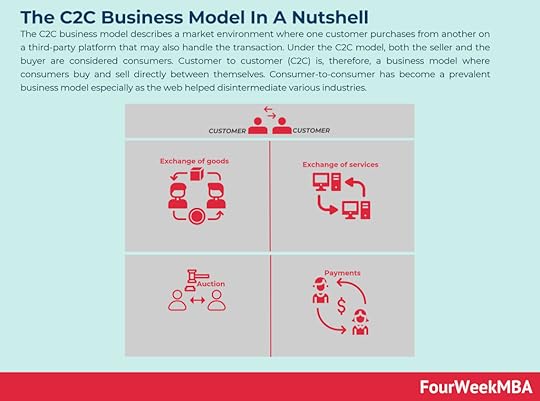 The C2C business model describes a market environment where one customer purchases from another on a third-party platform that may also handle the transaction. Under the C2C model, both the seller and the buyer are considered consumers. Customer to customer (C2C) is, therefore, a business model where consumers buy and sell directly between themselves. Consumer-to-consumer has become a prevalent business model especially as the web helped disintermediate various industries.B2B2C Business Model
The C2C business model describes a market environment where one customer purchases from another on a third-party platform that may also handle the transaction. Under the C2C model, both the seller and the buyer are considered consumers. Customer to customer (C2C) is, therefore, a business model where consumers buy and sell directly between themselves. Consumer-to-consumer has become a prevalent business model especially as the web helped disintermediate various industries.B2B2C Business Model A B2B2C is a particular kind of business model where a company, rather than accessing the consumer market directly, it does that via another business. Yet the final consumers will recognize the brand or the service provided by the B2B2C. The company offering the service might gain direct access to consumers over time.Account-Based Marketing
A B2B2C is a particular kind of business model where a company, rather than accessing the consumer market directly, it does that via another business. Yet the final consumers will recognize the brand or the service provided by the B2B2C. The company offering the service might gain direct access to consumers over time.Account-Based Marketing
 Account-based marketing (ABM) is a strategy where the marketing and sales departments come together to create personalized buying experiences for high-value accounts. Account-based marketing is a business-to-business (B2B) approach in which marketing and sales teams work together to target high-value accounts and turn them into customers.Retail Business Model
Account-based marketing (ABM) is a strategy where the marketing and sales departments come together to create personalized buying experiences for high-value accounts. Account-based marketing is a business-to-business (B2B) approach in which marketing and sales teams work together to target high-value accounts and turn them into customers.Retail Business Model
 A retail business model follows a direct-to-consumer approach, also called B2C, where the company sells directly to final customers a processed/finished product. This implies a business model that is mostly local-based, it carries higher margins, but also higher costs and distribution risks.Wholesale Business Model
A retail business model follows a direct-to-consumer approach, also called B2C, where the company sells directly to final customers a processed/finished product. This implies a business model that is mostly local-based, it carries higher margins, but also higher costs and distribution risks.Wholesale Business Model
 The wholesale model is a selling model where wholesalers sell their products in bulk to a retailer at a discounted price. The retailer then on-sells the products to consumers at a higher price. In the wholesale model, a wholesaler sells products in bulk to retail outlets for onward sale. Occasionally, the wholesaler sells direct to the consumer, with supermarket giant Costco the most obvious example.Direct-to-Consumer Business Model
The wholesale model is a selling model where wholesalers sell their products in bulk to a retailer at a discounted price. The retailer then on-sells the products to consumers at a higher price. In the wholesale model, a wholesaler sells products in bulk to retail outlets for onward sale. Occasionally, the wholesaler sells direct to the consumer, with supermarket giant Costco the most obvious example.Direct-to-Consumer Business Model
 Direct-to-consumer (D2C) is a business model where companies sell their products directly to the consumer without the assistance of a third-party wholesaler or retailer. In this way, the company can cut through intermediaries and increase its margins. However, to be successful the direct-to-consumers company needs to build its own distribution, which in the short term can be more expensive. Yet in the long-term creates a competitive advantage.Marketplace Business Models
Direct-to-consumer (D2C) is a business model where companies sell their products directly to the consumer without the assistance of a third-party wholesaler or retailer. In this way, the company can cut through intermediaries and increase its margins. However, to be successful the direct-to-consumers company needs to build its own distribution, which in the short term can be more expensive. Yet in the long-term creates a competitive advantage.Marketplace Business Models
 A marketplace is a platform where buyers and sellers interact and transact. The platform acts as a marketplace that will generate revenues in fees from one or all the parties involved in the transaction. Usually, marketplaces can be classified in several ways, like those selling services vs. products or those connecting buyers and sellers at B2B, B2C, or C2C level. And those marketplaces connecting two core players, or more.E-Commerce Business Models
A marketplace is a platform where buyers and sellers interact and transact. The platform acts as a marketplace that will generate revenues in fees from one or all the parties involved in the transaction. Usually, marketplaces can be classified in several ways, like those selling services vs. products or those connecting buyers and sellers at B2B, B2C, or C2C level. And those marketplaces connecting two core players, or more.E-Commerce Business Models
 We can classify e-commerce businesses in several ways. General classifications look at three primary categories:
We can classify e-commerce businesses in several ways. General classifications look at three primary categories:– B2B or business-to-business, where therefore a business sells to another company.
– B2C or business-to-consumer, where a business sells to a final consumer.
– C2C or consumer-to-consume, or more peer-to-peer where consumers sell to each other.Marketing vs. Sale
 The more you move from consumers to enterprise clients, the more you’ll need a sales force able to manage complex sales. As a rule of thumb, a more expensive product, in B2B or Enterprise, will require an organizational structure around sales. An inexpensive product to be offered to consumers will leverage on marketing. What is a low touch approach?
The more you move from consumers to enterprise clients, the more you’ll need a sales force able to manage complex sales. As a rule of thumb, a more expensive product, in B2B or Enterprise, will require an organizational structure around sales. An inexpensive product to be offered to consumers will leverage on marketing. What is a low touch approach? Under the low-touch business model, there is little to no direct interaction between the buyer and the seller. Therefore, most of the interactions that lead to the business transaction between customer and seller are automated or at least require little effort or competence. Therefore, the product and service might be either highly standardized. Or they might be customized via digital/tech features at scale.
What is low touch customer service?In low-touch customer service, customer support is mostly automated. Think of the case of a vending machine, which runs mostly on autopilot, as the customer can proceed with ha self-service procedure in picking up the product.
{ "@context": "https://schema.org", "@type": "FAQPage", "mainEntity": [ { "@type": "Question", "name": "What is a low touch approach?", "acceptedAnswer": { "@type": "Answer", "text": "<p>Under the low-touch business model, there is little to no direct interaction between the buyer and the seller. Therefore, most of the interactions that lead to the business transaction between customer and seller are automated or at least require little effort or competence. Therefore, the product and service might be either highly standardized. Or they might be customized via digital/tech features at scale. </p>" } } , { "@type": "Question", "name": "What is low touch customer service?", "acceptedAnswer": { "@type": "Answer", "text": "<p>In low-touch customer service, customer support is mostly automated. Think of the case of a vending machine, which runs mostly on autopilot, as the customer can proceed with ha self-service procedure in picking up the product. </p>" } } ] }The post What Is The Low-Touch Business Model? The Low-Touch Business Model In A Nutshell appeared first on FourWeekMBA.
Business Incubator In A Nutshell
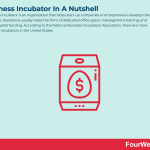

A business incubator is an organization that helps start-up companies or entrepreneurs develop their businesses. Assistance usually takes the form of dedicated office space, management training, and venture capital funding. According to the National Business Incubation Association, there are more than 1,400 incubators in the United States.
How does a business incubator work?Business incubators provide specially designed programs to help young companies innovate, grow, and realize their vision. These programs provide access to financial and technical services that result in numerous benefits to the owners of such a company.
For one, office space may be offered at below-market rates. Experts can also provide advice on business or marketing plans and give entrepreneurs access to a network of investors and other professional services such as accountants and lawyers.
Most companies utilize the services of a business incubator for around two years. During this time, multiple start-ups with a similar focus work in a shared area to reduce operating costs.
It’s important to note that not all business incubators are created equal. Many specialize in a particular industry and some have a more rigorous application process than others. In most cases, however, the start-up will be required to submit a detailed business plan and disclose all business-related activities. Once accepted, it must commit to undertaking the necessary training and be prepared to report to the business incubator’s management.
What does the business incubator expect in return?Business incubators do not accept every application – no matter how detailed a business plan may be.
Ultimately, they seek a return on investment and will take an equity stake in the business in exchange for services rendered. The shareholding is typically in the region of 2% to 10%. Alternatively, some may choose to charge a flat fee. Some incubators – including research organizations and educational institutions – may take a percentage of earnings from any resultant innovations.
While capital is useful to any start-up company, the amount of capital it receives from a business incubator may pale in comparison to how much that equity is worth over the long term. Entrepreneurs should note that while the incubator is invested in their success to some extent, they are nonetheless paying to be part of an incubator program where the incubator may take profits at the earliest opportunity.
Four types of business incubatorThough every business incubator shares the common goal of facilitating growth, they can nevertheless be broadly categorized into four types:
Non-profit development incubatorsThese are non-profit or government agencies designed to stimulate economic development. Many of these business incubators work with companies with a focus on public welfare or the improvement of society.
Corporate incubatorsWhose primary objective is to enhance the entrepreneurial skillset of a start-up and help it remain competitive relative to its peers. Corporate incubators focus on internal and external company projects.
Private investor incubatorsThese incubators assist high-potential businesses by taking a stake in the company and selling at some point in the future. Many tech start-ups enter into this sort of arrangement.
Academic incubatorsIn response to increasingly dynamic and competitive markets, universities foster strategic partnerships between academia and industry to help graduates develop relevant, long-term skills.
Key takeaways:A business incubator is an organization that helps start-up companies or entrepreneurs develop their businesses. Assistance usually takes the form of dedicated office space, management training, and venture capital funding.In exchange for providing assistance, the business incubator takes an equity stake in the start-up of between 2% and 10%. Research and educational incubators may opt to take a percentage of the earnings resulting from any innovative products.There are four broad types of business incubators: non-profit development, corporate, private investor, and academic. All share the common goal of facilitating growth.Main Free Guides:
Business ModelsBusiness CompetitionBusiness StrategyBusiness DevelopmentDigital Business ModelsDistribution ChannelsMarketing StrategyPlatform Business ModelsRevenue ModelsTech Business ModelsBlockchain Business Models FrameworkConnected Concepts To Business IncubatorAngel Investing An angel investor is usually a high net-worth individual who invests in early-stage start-ups in exchange for equity in the company. Angel investors are wealthy private investors focused on financing small business ventures in exchange for an equity stake. Unlike a venture capital firm, an angel investor invests their own capital during the early stages of a start-up when the risk of failure is relatively high, yet it might in the long-term unlock higher rates of return. Venture Capital
An angel investor is usually a high net-worth individual who invests in early-stage start-ups in exchange for equity in the company. Angel investors are wealthy private investors focused on financing small business ventures in exchange for an equity stake. Unlike a venture capital firm, an angel investor invests their own capital during the early stages of a start-up when the risk of failure is relatively high, yet it might in the long-term unlock higher rates of return. Venture Capital A venture capitalist generally invests in companies and startups which are still in a stage where their business model needs to be proved viable, or they need resources to scale up. Thus, those companies present high risks, but the potential for exponential growth. Therefore, venture capitalists look for startups that can bring a high ROI and high valuation multiples.Economic Moat
A venture capitalist generally invests in companies and startups which are still in a stage where their business model needs to be proved viable, or they need resources to scale up. Thus, those companies present high risks, but the potential for exponential growth. Therefore, venture capitalists look for startups that can bring a high ROI and high valuation multiples.Economic Moat Economic or market moats represent the long-term business defensibility. Or how long a business can retain its competitive advantage in the marketplace over the years. Warren Buffet who popularized the term “moat” referred to it as a share of mind, opposite to market share, as such it is the characteristic that all valuable brands have.Meme Investing
Economic or market moats represent the long-term business defensibility. Or how long a business can retain its competitive advantage in the marketplace over the years. Warren Buffet who popularized the term “moat” referred to it as a share of mind, opposite to market share, as such it is the characteristic that all valuable brands have.Meme Investing Meme stocks are securities that go viral online and attract the attention of the younger generation of retail investors. Meme investing, therefore, is a bottom-up, community-driven approach to investing that positions itself as the antonym to Wall Street investing. Also, meme investing often looks at attractive opportunities with lower liquidity that might be easier to overtake, thus enabling wide speculation, as “meme investors” often look for disproportionate short-term returns.Payment for Order Flow
Meme stocks are securities that go viral online and attract the attention of the younger generation of retail investors. Meme investing, therefore, is a bottom-up, community-driven approach to investing that positions itself as the antonym to Wall Street investing. Also, meme investing often looks at attractive opportunities with lower liquidity that might be easier to overtake, thus enabling wide speculation, as “meme investors” often look for disproportionate short-term returns.Payment for Order Flow Payment for order flow consists of a “kickback” or commission that the broker routing customers to a market maker (in charge of enabling the bid and ask price) will pay a commission to the broker as a sort of market-making fee.What is a SPAC
Payment for order flow consists of a “kickback” or commission that the broker routing customers to a market maker (in charge of enabling the bid and ask price) will pay a commission to the broker as a sort of market-making fee.What is a SPAC A special purpose acquisition company (SPAC) is a company with no commercial operations that are created to raise capital through an IPO to acquire another company. The SPAC is also called for that reason a “blank check company” as it will use the money provided by investors to enable private companies to go public via the SPAC.
A special purpose acquisition company (SPAC) is a company with no commercial operations that are created to raise capital through an IPO to acquire another company. The SPAC is also called for that reason a “blank check company” as it will use the money provided by investors to enable private companies to go public via the SPAC.The post Business Incubator In A Nutshell appeared first on FourWeekMBA.



